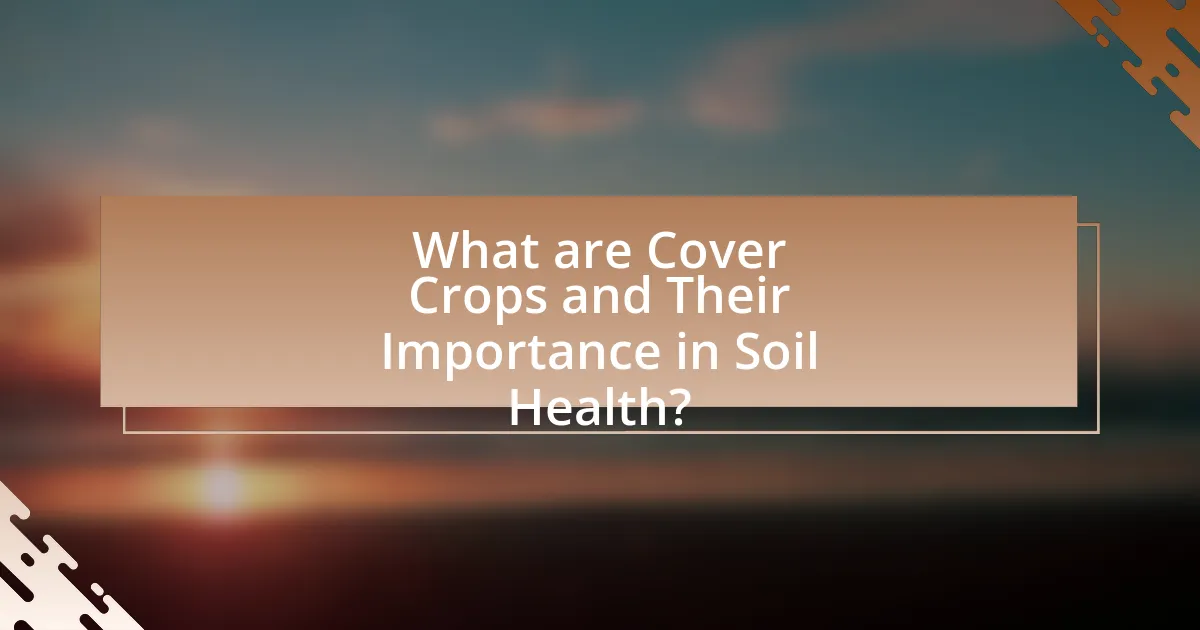Cover crops are plants cultivated primarily to enhance soil health rather than for harvest, playing a vital role in improving soil structure, preventing erosion, and increasing organic matter. They contribute to soil health by enhancing nutrient availability, promoting biodiversity, and reducing soil compaction. Common types of cover crops include legumes, grasses, and brassicas, each offering specific benefits such as nitrogen fixation and erosion control. The article explores the importance of cover crops in sustainable agriculture, their impact on soil fertility and biodiversity, and best practices for their effective integration into farming systems. Additionally, it addresses challenges farmers face in adopting cover crops and strategies to overcome these obstacles.

What are Cover Crops and Their Importance in Soil Health?
Cover crops are plants grown primarily to improve soil health rather than for harvest. They play a crucial role in enhancing soil structure, preventing erosion, and increasing organic matter. Research indicates that cover crops can reduce soil compaction and improve water infiltration, which leads to better nutrient availability for subsequent crops. For example, a study published in the journal “Agronomy” by Clark et al. (2019) found that using cover crops increased soil organic carbon levels by 0.5 to 1.0 tons per hectare annually, demonstrating their effectiveness in promoting soil health.
How do cover crops contribute to soil health?
Cover crops contribute to soil health by enhancing soil structure, increasing organic matter, and promoting biodiversity. These crops, such as clover and rye, improve soil aeration and water infiltration, which reduces erosion and compaction. Additionally, cover crops add organic matter when they decompose, enriching the soil with nutrients and improving its fertility. Research indicates that cover crops can increase soil organic carbon levels by 0.1 to 0.5% per year, which is crucial for maintaining soil health. Furthermore, they support beneficial microorganisms and insects, fostering a diverse ecosystem that contributes to nutrient cycling and pest management.
What specific benefits do cover crops provide to soil structure?
Cover crops enhance soil structure by improving aggregation, increasing porosity, and reducing compaction. These plants contribute organic matter through root biomass and decaying plant material, which fosters the formation of stable soil aggregates. Research indicates that cover crops can increase soil porosity by up to 20%, allowing for better water infiltration and root penetration. Additionally, the root systems of cover crops create channels in the soil, which helps alleviate compaction and promotes aeration. This improved soil structure ultimately leads to enhanced nutrient availability and better overall soil health.
How do cover crops enhance soil fertility?
Cover crops enhance soil fertility by improving nutrient availability and soil structure. They achieve this through processes such as nitrogen fixation, where legumes convert atmospheric nitrogen into a form usable by plants, thus enriching the soil. Additionally, cover crops prevent soil erosion, promote organic matter accumulation, and enhance microbial activity, all of which contribute to a healthier soil ecosystem. Research indicates that fields with cover crops can show a significant increase in soil organic carbon levels, which is crucial for nutrient retention and overall soil health.
Why are cover crops considered a sustainable agricultural practice?
Cover crops are considered a sustainable agricultural practice because they enhance soil health, improve nutrient cycling, and reduce erosion. By planting cover crops, farmers can increase organic matter in the soil, which promotes microbial activity and improves soil structure. Research indicates that cover crops can reduce nitrogen leaching by up to 50%, thereby minimizing water pollution and enhancing nutrient retention. Additionally, cover crops prevent soil erosion by providing ground cover, which stabilizes the soil and reduces runoff during heavy rains. These practices contribute to long-term agricultural sustainability by maintaining soil fertility and promoting biodiversity.
What role do cover crops play in reducing soil erosion?
Cover crops play a crucial role in reducing soil erosion by providing ground cover that protects the soil from wind and water impact. This protective layer helps to stabilize the soil structure, preventing the loss of topsoil, which is essential for maintaining soil fertility. Research indicates that cover crops can reduce soil erosion rates by up to 90% compared to bare soil, as they enhance soil organic matter and improve water infiltration. Additionally, the root systems of cover crops bind soil particles together, further mitigating erosion risks during heavy rainfall events.
How do cover crops improve biodiversity in agricultural systems?
Cover crops improve biodiversity in agricultural systems by providing habitat and food sources for various organisms, including beneficial insects, soil microbes, and wildlife. These crops enhance soil structure and health, which supports a diverse range of plant and animal life. Research indicates that cover crops can increase the abundance and diversity of soil microorganisms, which are crucial for nutrient cycling and soil fertility. For example, a study published in the journal “Agriculture, Ecosystems & Environment” found that fields with cover crops had significantly higher microbial diversity compared to those without, demonstrating their role in fostering a more resilient ecosystem.

What Types of Cover Crops Are Commonly Used?
Commonly used cover crops include legumes, grasses, and brassicas. Legumes such as clover and vetch fix nitrogen in the soil, enhancing fertility. Grasses like rye and oats improve soil structure and prevent erosion. Brassicas, including radishes, help break up compacted soil and improve drainage. These cover crops contribute to soil health by increasing organic matter, enhancing microbial activity, and reducing weed pressure.
What are the most popular cover crop species?
The most popular cover crop species include clover, rye, vetch, and radish. Clover, particularly red and white varieties, is favored for its nitrogen-fixing capabilities, enhancing soil fertility. Rye is commonly used for its ability to suppress weeds and prevent soil erosion, while vetch also contributes nitrogen and improves soil structure. Radish, especially tillage radish, is known for its deep taproot that helps break up compacted soil and improves water infiltration. These species are widely recognized for their benefits in promoting soil health and sustainability in agricultural practices.
How do legumes function as cover crops?
Legumes function as cover crops by fixing atmospheric nitrogen in the soil, which enhances soil fertility. This process occurs through symbiotic relationships with nitrogen-fixing bacteria in their root nodules, allowing legumes to convert nitrogen gas into a form usable by plants. Research indicates that legumes can increase soil nitrogen levels by 50 to 200 pounds per acre, significantly benefiting subsequent crops. Additionally, legumes improve soil structure and reduce erosion, contributing to overall soil health.
What are the benefits of using grasses as cover crops?
Grasses as cover crops provide numerous benefits, including soil erosion control, improved soil structure, and enhanced nutrient cycling. These grasses establish a protective layer over the soil, reducing the impact of rainfall and wind, which minimizes erosion. Additionally, their root systems help to improve soil structure by creating channels that enhance water infiltration and aeration. Grasses also contribute to nutrient cycling by capturing nitrogen and other nutrients, which can be released back into the soil when the cover crop is terminated, thus improving soil fertility. Studies have shown that using grasses as cover crops can increase organic matter content and promote beneficial microbial activity, further supporting soil health.
How do different cover crops affect soil health differently?
Different cover crops affect soil health in various ways, primarily through their impact on soil structure, nutrient cycling, and microbial activity. For instance, legumes like clover and vetch enhance nitrogen availability in the soil, improving fertility and supporting plant growth. In contrast, deep-rooted cover crops such as radishes can break up compacted soil layers, enhancing aeration and water infiltration. Additionally, cover crops like rye can suppress weeds and reduce erosion, contributing to overall soil stability. Research indicates that diverse cover crop mixtures can lead to improved soil organic matter and microbial diversity, which are critical for long-term soil health. Studies have shown that fields with cover crops exhibit higher soil organic carbon levels, which is essential for nutrient retention and soil structure.
What factors should be considered when selecting cover crops for specific soils?
When selecting cover crops for specific soils, factors such as soil type, nutrient availability, climate conditions, and the intended purpose of the cover crop must be considered. Soil type influences the choice of cover crops, as different species thrive in various soil textures and structures; for example, legumes are beneficial in nitrogen-deficient soils due to their ability to fix atmospheric nitrogen. Nutrient availability is crucial, as certain cover crops can enhance soil fertility or compete for nutrients, impacting subsequent crops. Climate conditions, including temperature and precipitation patterns, affect the growth and survival of cover crops, making it essential to choose species that are well-suited to local environmental conditions. Lastly, the intended purpose—such as erosion control, weed suppression, or improving soil structure—guides the selection process, ensuring that the chosen cover crop aligns with specific agricultural goals.
How do cover crop mixtures compare to single species in terms of soil health benefits?
Cover crop mixtures provide greater soil health benefits compared to single species. Mixtures enhance biodiversity, which improves soil structure, increases organic matter, and promotes a wider range of microbial activity. Research indicates that diverse cover crop systems can lead to improved nutrient cycling and reduced soil erosion. For instance, a study published in the journal “Agronomy” by Teasdale et al. (2019) found that cover crop mixtures significantly increased soil organic carbon levels and microbial biomass compared to monocultures. This evidence supports the conclusion that cover crop mixtures are more effective in enhancing soil health than single species.

What Practices Enhance the Effectiveness of Cover Crops?
Practices that enhance the effectiveness of cover crops include selecting appropriate species, optimizing planting and termination timing, and implementing proper management techniques. Selecting species that are well-suited to local soil and climate conditions can improve biomass production and nutrient cycling. For instance, legumes can fix nitrogen, while deep-rooted species can improve soil structure. Optimizing planting and termination timing ensures that cover crops provide maximum benefits, such as erosion control and weed suppression, during critical periods. Additionally, employing management techniques like no-till practices can enhance soil health by minimizing disturbance and preserving soil structure. Research indicates that these practices can lead to improved soil organic matter and overall soil health, as demonstrated in studies conducted by the USDA Agricultural Research Service.
How should cover crops be managed for optimal soil health benefits?
Cover crops should be managed by selecting appropriate species, timing their planting and termination, and implementing proper nutrient management to maximize soil health benefits. Selecting species such as legumes can enhance nitrogen fixation, while grasses can improve soil structure and reduce erosion. Timing is crucial; cover crops should be planted early enough to establish before winter and terminated at the right growth stage to optimize biomass and nutrient release. Research indicates that well-managed cover crops can increase soil organic matter by 0.1 to 0.5% annually, enhancing soil fertility and microbial activity. Proper nutrient management, including the use of soil tests, ensures that cover crops contribute effectively to nutrient cycling and soil health.
What are the best planting and termination practices for cover crops?
The best planting practices for cover crops include selecting appropriate species based on climate, soil type, and desired benefits, such as nitrogen fixation or erosion control. For instance, legumes like clover enhance soil nitrogen levels, while grasses like rye provide excellent ground cover. Planting should occur at optimal times, typically in late summer or early fall, to ensure adequate growth before winter.
Termination practices involve methods such as mowing, rolling, or using herbicides, with the timing being crucial to maximize biomass and nutrient release. Termination should ideally occur before the cover crop flowers to prevent seed set, which can lead to unwanted volunteer plants. Research indicates that terminating cover crops 2-3 weeks before planting the main crop allows for effective nutrient cycling and soil health improvement.
How does timing affect the benefits of cover crops?
Timing significantly influences the benefits of cover crops by determining their growth period and effectiveness in enhancing soil health. When cover crops are planted at optimal times, such as immediately after cash crop harvest or before winter, they can effectively prevent soil erosion, improve soil structure, and enhance nutrient cycling. Research indicates that cover crops planted in the fall can reduce nitrogen leaching by up to 50% compared to bare soil, as they absorb excess nutrients and prevent runoff. Additionally, timely planting allows cover crops to establish a robust root system, which contributes to soil aeration and organic matter accumulation, further promoting soil health.
What challenges do farmers face when implementing cover crops?
Farmers face several challenges when implementing cover crops, including increased costs, management complexity, and potential impacts on cash crop yields. The initial investment for seeds and planting can be significant, which may deter farmers, especially those with tight budgets. Additionally, managing cover crops requires knowledge and skills that some farmers may lack, leading to difficulties in integrating them into existing farming practices. Research indicates that cover crops can compete with cash crops for nutrients and water, potentially reducing yields if not managed properly. For instance, a study published in the journal “Agronomy” found that improper management of cover crops can lead to a 10-20% decrease in cash crop yields in certain conditions.
How can farmers overcome common obstacles to cover crop adoption?
Farmers can overcome common obstacles to cover crop adoption by implementing education and financial support programs. Education initiatives, such as workshops and field days, can inform farmers about the benefits of cover crops, including improved soil health and reduced erosion. Financial support, such as cost-sharing programs or grants, can alleviate the economic burden associated with seed purchase and management. Research indicates that states with robust educational outreach and financial assistance see higher adoption rates of cover crops, demonstrating the effectiveness of these strategies in addressing barriers to adoption.
What are the best practices for integrating cover crops into farming systems?
The best practices for integrating cover crops into farming systems include selecting appropriate species, timing the planting and termination, and managing the biomass effectively. Selecting species that are well-suited to the local climate and soil conditions enhances benefits such as nitrogen fixation and weed suppression. Timing is crucial; cover crops should be planted early enough to establish before winter and terminated at the right growth stage to maximize nutrient release and minimize competition with cash crops. Effective biomass management involves incorporating cover crops into the soil or using them as mulch to improve soil structure and organic matter. Research indicates that these practices can lead to improved soil health, increased crop yields, and enhanced resilience against erosion and nutrient leaching.










